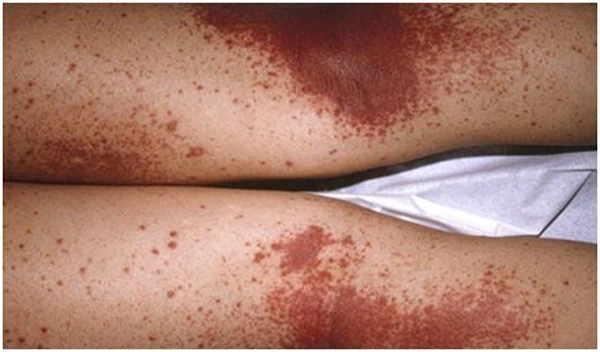
Differential Diagnoses:
Kawasaki disease
Erythema multiforme
Systemic lupus erythematosus
Meningococcemia
Disseminated intravascular coagulation
Thrombocytopenic purpura
Diagnosis: Henoch-Schönlein purpura (HSP)
Learnings: HSP is an idiopathic cutaneous small-vessel vasculitis characterized by deposition of immunoglobulin A (IgA) in vessel walls. The disease occurs mostly in children, with a peak incidence at age 5 to 6 years. The incidence of HSP is estimated to be approximately 10 in 100,000 children per year. A history of preceding upper respiratory tract infection is frequently elicited. Patients may have a history of 2 to 3 weeks of fever, headache, myalgias, arthralgias, and abdominal pain preceding the skin eruption.
Extracutaneous manifestations include arthritis, gastrointestinal bleeding, pulmonary hemorrhage, and nephritis. Renal involvement is typically mild and self-limited, with transient microscopic hematuria and minimal proteinuria. However, approximately 2% of patients progress to end-stage renal disease.
Consensus criteria for the diagnosis of HSP includes palpable purpura plus at least one of the following:
- Diffuse abdominal pain
- Acute arthritis or arthralgias
- Renal involvement
- A skin biopsy showing IgA deposition
The spread of purpura to the upper parts of the trunk portends a higher likelihood of renal involvement. In patients with severe abdominal pain, consider an acute surgical abdomen, intussusception, or paralytic ileus.
Look for linear purpura in areas of externally applied pressure, such as by elastic at the top of socks on the legs and by wrinkles of hospital bed sheets on the back in a recumbent patient.
What to Look For: Erythematous macules and papules or urticarial lesions that quickly evolve into purpura within 24 hours. Vesicles, bullae, and necrotic ulcers may also be seen. Lesions are symmetrically distributed over the buttocks, distal legs, and extensor extremities, but they may occasionally involve the trunk and face. Individual lesions resolve with hyperpigmentation over 5 to 7 days, but recurrent crops tend to appear over a period of 6 to 16 weeks.
Acknowledgment: Image courtesy of Logical Images, Inc. (www.VisualDx.com/JUCM)
